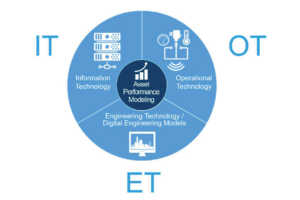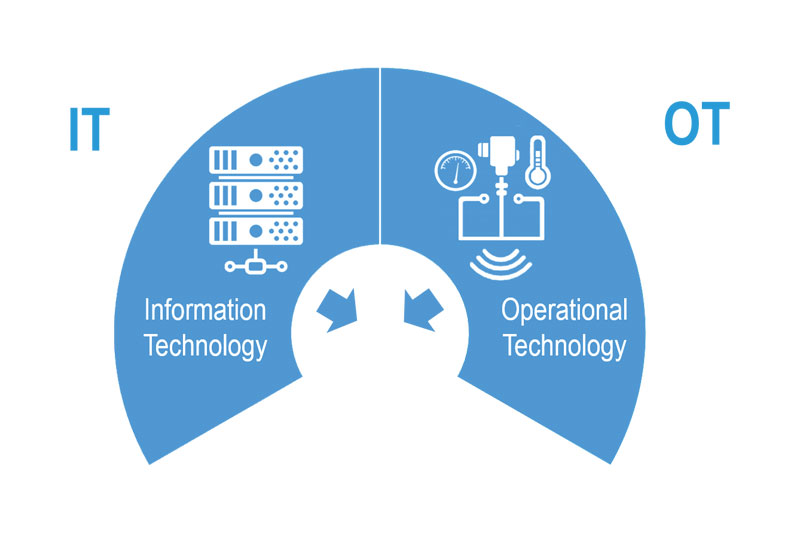Connecting IT with Operational and Engineering Technology for Asset Performance Modeling
Bhupinder Singh, Chief Product Officer at Bentley Systems, explains how the top company is leading the change
As operations technology (OT) leverages the Industrial Internet of Things (IIoT) with sensors on operating equipment and assets producing an enormous volume of big data, there is a need for improved security, information sharing and data management. This, in turn, is driving an unprecedented convergence with IT. However, organizations are struggling to make use of the data from their OT and IT systems, causing them to miss opportunities to improve asset performance. This is due, in part, to the fact that the digital engineering models developed during the engineering phase of capital projects, are typically not playing a role in operations.
What if owner-operators could use these models in operations? Imagine how a digital engineering model—the engineering technology or ET of an asset—could help operations and maintenance people forecast problems, do better planning, and improve performance. It is now possible for companies to converge their IT, OT and ET – and seamlessly integrate process and information flows between them – to enable asset performance modeling to deliver actionable intelligence for decision support through an immersive environment for visual operations.
The Digital Engineering Model
For many years, engineering departments have been using advanced modeling and simulation applications that focus on the process of design and construction of an infrastructure asset – a plant, bridge, highway, railway or utility network – in a way that improves project delivery and asset performance. Better project delivery enables companies to optimize CAPEX – through both the depth of information modeling and the breadth of information mobility for collaboration during design and construction.
There’s a staggering amount of information related to assets– detailed component specifications, precise geo-location, configuration management, fabrication details, cost information, predicted lifetimes, recommended maintenance and repair information. Today’s engineering technology makes it possible to bring all of this information together within the federated digital engineering model, making it possible to track, access, and share with others collaborating on the project. The technology also enables engineers to model projects in a 3D virtual setting for design integration and construction work packaging, so that when the project is actually constructed in the real world, the project teams and stakeholders are able to minimize unforeseen situations and keep the project on track.

Ideally, all of this information flows between applications and project teams for better project delivery, which is the key to better CAPEX, and flows through to operations and maintenance systems across the entire asset lifecycle, which is key to reducing OPEX. For example, when companies can integrate the 3D models for each discipline involved in a project, it improves information mobility. Disciplines can more effectively communicate critical design details for operations, detect clashes earlier in the design phase and before construction starts, share updates during the engineering and construction phases, and hand over accurate and complete information to ensure a successful start-up and ongoing operations.
The Beginning of IT/ET/OT Convergence
The Industrial Internet of Things (IIoT) is driving a convergence between operational technology and information technology. Digital engineering models can accelerate this convergence and add the visual representation of the real world needed to aid decision making; this can have far-reaching impacts on the safety, productivity, efficiency and operations of industries worldwide.
For example, consider how South Australia Water is currently using predictive and real-time operational analytics to forecast water demand and improve customer service while reducing operational costs. To create a demand forecasting tool, they needed to pull information from both the operational and IT sides of the organization in real time.
Bentley’s predictive analytics software was chosen as the operational intelligence platform due to its real-time ability to connect and capture data from a wide variety of sources, ability to perform complicated calculations and analysis, and its impressive visualization capabilities. Real-time monitored sensor data is brought in from the reservoirs, water treatment plants, valves, flowmeters, and pumps spread across the extensive pipeline network. This operational data is combined in real time with climate, energy, cost, and population data and is displayed on dashboards. Bringing these data sources together has resulted in huge benefits, including improved performance, enhanced understanding of interrelationships, and better decision-making and more accurate predictions of short- and long-term demand.
South Australia Water also integrated a demand optimization tool that is used to optimize the availability and the movement of clean water around the network to demand areas quickly and efficiently. It calculates how to deliver the water by calculating costs and determining which pumping stations to use, which pumps are needed, and so on. Built-in analytics take the output of the demand forecasting tool to develop a live hydraulic model that determines water pressures and flows throughout the network. Using this digital engineering model, South Australia Water can actively optimize water supply and reliability to its customers. Customers enjoy improved water security, and response times to problems, such as broken water mains, have been reduced by 90 percent.
Tying together IT, OT, and ET also allows the company to take advantage of lower forward market pricing for electricity. They can use an energy portfolio management spot-market power price tool to determine the optimal timing for pump operations on five pipelines, as well as when to purchase power in highly volatile markets. The impact on OPEX can be significant – a savings of AUD 3 million per year.

Making the Leap to Asset Performance Modeling
Taking the convergence of IT, OT, and ET one step further, it’s now possible to enable real-time asset performance modeling, which ensures that assets are safe, reliable, and efficient over their operating life. For example, Bentley’s asset performance management software enables companies to develop both operational and asset strategies for improving reliability and maintaining asset performance and predictable production. Using a common data environment (CDE), companies can collect, consolidate, and analyze data and turn it into actionable intelligence. The software also helps ensure regulatory compliance and is aligned with asset management standards, including PAS 55 and ISO 55001. At the same time, it applies leading information modeling and information management technologies to asset operations and maintenance, and when combined with information delivered at handover from projects, provides a complete lifecycle information management solution for owner-operators. This enables owner-operators to optimize processes for the day-to-day running of assets, balancing capital and operational costs and maximizing production capability.
Many companies are already on their way to using these solutions, thanks to widespread adoption of condition monitoring technologies. Monitoring assets require integration of IT and OT systems, as well as big data analytics to discern patterns in data and automate or recommend optimal responses to them.
To move to asset performance modeling, 3D digital engineering models across all disciplines are integrated with the IT and OT systems used for asset performance monitoring. As the operating baseline for infrastructure assets, digital engineering models bring together schematics; engineering analyses; network models; 3D models; functional components, catalogs, and specifications.
As it states Bhupinder Singh, Chief Product Officer at Bentley Systems "It is helpful to think of digital engineering information as the digital DNA for infrastructure assets – down to every nut, bolt, and screw. Just as doctors can analyze human DNA to anticipate health issues and personalize healthcare for better health outcomes, companies can harness the digital DNA of their assets to personalize asset maintenance for better TOTEX, maximized uptime and more."
For example, companies can manage the performance of their assets far more effectively when they have digital engineering models that intelligently bring together all infrastructure data. When IT and OT systems connect with this ET data, teams can view the asset performance history, see all failure alerts, geo-coordinate to the exact positioning within the infrastructure asset, and drill down into the 3D digital engineering model to determine the cause of the alarm. Then they can refer to the manufacturer’s degradation data, access maintenance and repair data information, and take corrective action – all in seconds.
Engineering in Context
These same technologies also allow designers to engineer – and reengineer – in context. For example, when making the decision to repair, replace or remove, rather than starting from scratch or using an existing design model, the engineer or designer can use the continuously surveyed model of the plant or asset as the accurate, 3D representation for the decision. They can walk through the model virtually and explore the options for adding or replacing with new equipment right in the context of the 3D reality mesh. Once the engineering is approved and construction or replacement begins, the same continuous surveying technique can continuously generate a new 3D reality mesh to track progress and finally create the new point of reference for IT, OT, and ET. Everyone involved can instantly see conditions change as construction progresses – and once work is complete, owner-operators can continuously monitor and model assets to assess conditions, drill down into alerts and issues, take informed action, and optimize asset performance.
Seamless Integration of Processes and Information
We are at an incredibly exciting convergence in the world of asset management. The ability to work in a comprehensive modeling environment, leveraging ContextCapture and 3D reality mesh technologies, and connecting with the Industrial Internet of Things through asset management and predictive analytics software, companies can converge their information technology, operational technology and engineering technology – and seamlessly integrate processes and information flows between them. The next generation of engineers – digital natives – will no doubt find ways to exploit this convergence in unprecedented ways. We can realize immediate benefits today, by using these technologies to make more informed decisions regarding when to repair, retire, or replace assets so that they are safer, more reliable, and maximally efficient over their operating life.












